|
Savona
Savona is the Provincial capital, the largest town on the Riviera di Ponente.
The name Sann-a has ita roots in the town's ancient inhabitants, tha Sabazi Ligurians, who sided with Cathage in the Punic war against Hannibal, unlike the Genoese who became allies of the Romans: while there's no love lost between Savona and Genoa, the two thousand years. In the 13th century Savona was a free Commune, at war with the Genoese nonetheless, who seized power once and for all in 1528 and razed the town's fine port to the ground. It was Napoleone and, in the 19th century, the Savoia dynasty who turned Savona back into a town worthy of the name, building it a real port. Savona still has traces of the medievale and baroque in its old docks, of 19th century style in its long, straight porticoes and elegant Piedmont-esque squares and of the moderne movement along the banks of the river Letimbro, often no more than a stream.
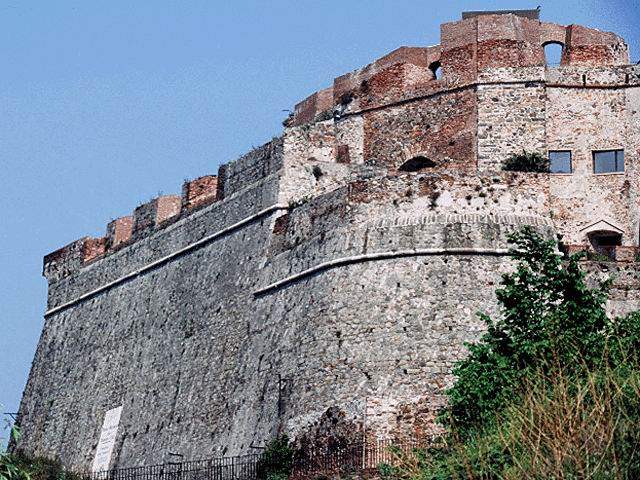
The core of the town stood on a hilltop overlooking the sea, where in 1542 the Republic of Genoa built a imposing military stronghold, the Priamar, now home to the non-hostile museums of contemporary art.
In the 17th century, it was here that the Republic of Genoa's chief archer, Giovan Battista Baliani, experimented with friction and mechanical bodies just as Galileo did before him; Baliani anticipated Torricelli's studies and distinguished between the concept of weight and mass as Newton was to do later.
Savona's Medieval historic centre is clearly Ligurian in its layout, complete with caruggi and houses within towers. Its buildings are of great historical importance not least for their architecture: the State Archives house the first document written in the Ligurian vernacular (the Dichiarazione di Paxia, 1178-1182).
The heart of 19th century Savona lies in porticoed Via Paleocapa, its buildings richly decorated with Art Nouveau motifs, and Piazza Diaz, dominated by the imposing Chiabrera Theatre which is named after Savona's greatest poet, the greatest exponent of 17th century literature. Towards the sea at the end of Via Paleocapa stands the short but imposing Leon Pancaldo tower, the last remaining traces of the 14th century walls; it is named after a Savonese sailor who accompanied Magellano on his travels.
Opposite stands the modern cruise terminal, reflecting 21st century Savona's vocation for sea travel and tourism, welcoming and friendly towards all visitors.
Our tour centres on the square formed by Via Paleocapa, Corso Italia, Corso Mazzini and the old Docks. Start from the Medieval towers which rise above the oldest part of the port: the Corsi and Guarnieri towers date from the 12th century, as does the tower of the Brandale or belltower (the brandale was actually the pole from which the Commune's flag flew). Its Huge bell stands in Campanassa. Nearby Palazzo degli Anziani was once the seat of the podesta or magistrate. This marks the start of Via Pia, once known as the Fossalvaria and the oldest thoroughfare in old Savona. The road still has an important commercial role to play today. Its main feature is the 15th century Palazzo Della Rovere, built by the family which produced two great Renaissance popes, politicians and patrons both: Sixtus IV and Julius II.
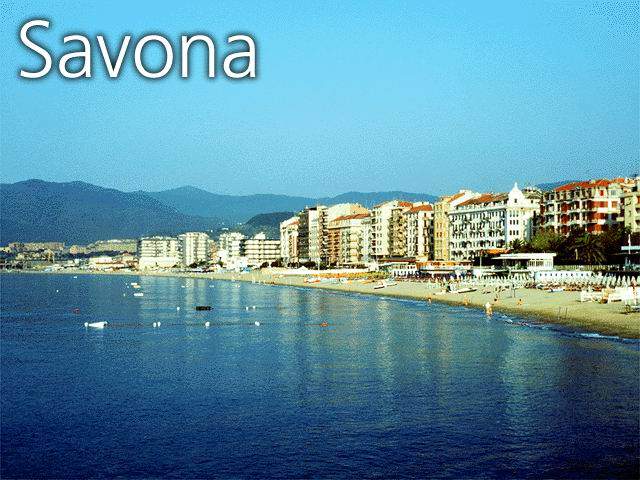 There are many buildings and ruined towers worth visiting in the nearby area. Via Pia leads on to the porticoes of Via Paleocapa, but it is worthwhile making a detour along Via Aonzo towards Piazzetta del Vescovado and the 18th century Palazzo Vescovile, not to mention the Cathedral square which stands at the rear of Palazzo Della Rovere. There are many buildings and ruined towers worth visiting in the nearby area. Via Pia leads on to the porticoes of Via Paleocapa, but it is worthwhile making a detour along Via Aonzo towards Piazzetta del Vescovado and the 18th century Palazzo Vescovile, not to mention the Cathedral square which stands at the rear of Palazzo Della Rovere.
The Duomo or cathedral of Santa Maria Assunta was built in the late 16th century to replace its predecessor which was demolished following the construction of the Priamar fortress.
It was Celle-born Francesco della Rovere, Pope Sixtus IV from 1471 to 1484, who commissioned this chapel and its much more illustrious counterpart in the Papal Palaces of the Vatican. Savona's own Sistine Chapel stands next to the chatedral. It was built by Lombard craftsmen between 1481 and 1483 as a mausoleum for the pope's parents. In the mid 18th century it was transformed ino a light, airy rococo jewel, decorated with colourful floral motifs in stucco work and embellished with paintings, a choir and 17th century organ and the funereal monument built in 1483. It is without doubt one of the region's greatest artistic treasures.
Woodlands around Savona: you can see that Savona is the Provincial capital with the greatest forestry cover in the whole of Italy as soon as you leave the town and begin to climb the hills around it: this was Savona Wood, vast forests of prized timber which for centuries supplied the shipyards of the Republic of Genoa, particularly those in nearby Varazze. The woods are just as densely packed and untamed today; very few roads run through them and you are much more likely to come across a herd of grazing cows than a car. It is well worth travelling up through the valley of the Letimbro to the 6th/7th century Sanctuary of Nostra Signora della Misericordia, with its pretty square and Palazzo Pallavicino and Tursi, not to mention a marble depiction of the Visitation, perhaps by Bernini. The road rolls on into the countryside towards Montenotte, site (in 1796) of one of the numerous battles which launched Napoleon's ephemeral conquest of Italy and Europe. After the hush of so many trees, the Giovo pass offers more obvious traces of human civilisation, first in the shape of a refuge, final destination for the forest's many mountain horse riding trails which offer views of the stunning natural landscape that no motorised means can rival. Then the landscape begins to slowly change from the mountainous to the agricultural as you make your way down towards the sea through the isolated villages of the Commune of Stella, amid terraced gardens, broom trees and olive groves.
The small town of Savonese province
.jpg) Varazze: a marina packed with pristine white sailing boats, set against a backdrop of rocky peaks and cluster pines: approaching Varazze from the coast road (the "Aurelia"), it is easy to see why the Romans called it ad Navalia. The name Varagine, coined as early as 967, had the same meaning: woodland thick with excellent timber for boat building, and beaches ideal for launching craft; the links between Varazze and the sea are among the oldest and most stable to be found anywhere in Liguria. Not forgetting its shipyards, first and foremost Baglietto, which have brought honour to this charming town throughout the 20th century and beyond. Of course, people eventually realised that the sea could be used for bathing, revitalising and warming their minds and bodies after a year of wintry skies, or simply strolling along the palm-lined flowering promenade. The era of vacationing had begun. Varazze: a marina packed with pristine white sailing boats, set against a backdrop of rocky peaks and cluster pines: approaching Varazze from the coast road (the "Aurelia"), it is easy to see why the Romans called it ad Navalia. The name Varagine, coined as early as 967, had the same meaning: woodland thick with excellent timber for boat building, and beaches ideal for launching craft; the links between Varazze and the sea are among the oldest and most stable to be found anywhere in Liguria. Not forgetting its shipyards, first and foremost Baglietto, which have brought honour to this charming town throughout the 20th century and beyond. Of course, people eventually realised that the sea could be used for bathing, revitalising and warming their minds and bodies after a year of wintry skies, or simply strolling along the palm-lined flowering promenade. The era of vacationing had begun.
Today the beaches of Varagine welcome tourists who travel to the Riviera delle Palme to discover and cherish the charms of the Mediterranean.
Before they reach the beaches, visitors are welcomed by the citizens of Varazze itselfs, by its fishermen, hoteliers and farmers from the hills: every year the local people open their arms to all those who travel from Piedmont, Lombardy, Germany and the rest of Europe to enjoy a well-earned holiday in peaceful yet exciting surroundings, be their destination an elegant four star hotel or family-run pensione.
One can read the history of Varazze in the Mediaeval ramparts which once encircled it. With the northern part still standing today, the ramparts incorporate the ruins of the primitive Romanesque church of Sant'Ambrogio, witness to the presence of the church of Milan in Varazze in the early Middle Ages; the new church of Sant'Ambrogio dates from the sixteenth century, but its red belltower survives from an earlier Romanesque-gothic church built by the Lombards. Also well worth a visit are the churches of Santi Nazario e Celso, with its a risseu courtyard (decorated with colourful riverbed pebbles in beautiful geometric and seathemed patterns), and San Domenico; embedded in the facade of the latter is the cannonball which was fired at the church from a French ship back in 1746.
A long, level promenade, first tarmacked then unpaved, which winds eastwards along the coast from the centre of Varazze to the mouth of the river Arrestra, easternmost boundary of the Province of Savona. The handful of tunnels which break up the stretch of road are a reminder that Varazze's Lungomare Europa was once home to the old railway line.
It ran past broom tress packed with stunning yellow flowers, dark thickets of holm oaks, the real lords of Mediterranean maquis, the seafront terrace which plays host to the Ivrea family's castle, and brief glimpses of elegant modern villas hidden amid the green surroundings of Piani di Invrea.
The promenade tempts the visitor to take a dip in the cool, invigorating waters or soak up the sun on one of the tiny, deserted beaches where there is no room for umbrellas, and the fantastical shapes of the cliffs mean inhibitions can be left behind.
The Aurelia winds its way along tortuously and secretly, almost disappearing way up high where this rocky stretch of the Varazze coastline is at its wildest and stillest.
Varazze has been welcoming tourists for over a century, and the town offers visitors the very best of the Riviera delle Palme in terms of hotel accommodation, bathing establishments and sports facilities. All this is topped off by an exceptional all-year round climate, with average temperatures ranging from 9°C in January to 25°C in August; in the summer months the sea reaches a balmy 26/27 degrees. It is hard to believe that a small, "perfectly formed" town like Varazze, blissfully free from the chaos and unfriendliness of our larger cities, boasts more than 100 hotels to suit all tastes, from grand four star establishments to the family-run pensione. Not to mention the town's many other tourist facilities, from holiday parks and campsites from tents and caravans, to farms, condominiums and private apartments.
The Desert of Varazze:
The Desert of Varazze is thus called for its lack of inhabitants. To reach the valley of the Arrestra, follow the road up from Varazze to Casanova, then wind your way along the bends which twist and turn around the seaward slope of Mount Beigua. You will emerge in a landscape of untainted beauty, thick with dark holm oaks and bay trees, a triumph of Mediterranean maquis, waiting to be explored on foot or horseback amid the deep silence of nature.
.jpg) Celle Ligure: Celle shares its name with a pretty town in the north of Germany. There, trellised houses and baronial castles speak to us of the lives and history of its inhabitants; here, the colourful facades of the tall buildings which look out over narrow caruggi or alleyways go to make in one of Liguria's most charming and best-kept seaside villages. Double rows if centuries-old houses, painted in bright, brilliant colours - enabling the fishermen of old to distinguish their homes from the sea - a long, winding passageway, closed to traffic and animated by a thousand-and-one tiny shops, by the hubbub of passers-by, and then a long sandy beach lined with multicoloured bathing huts and sunshades joins the village to the great blue plateau out yonder, stretching off to the east towards the leafy new area of Piani di Celle and, beyond, to Varazze. Celle Ligure: Celle shares its name with a pretty town in the north of Germany. There, trellised houses and baronial castles speak to us of the lives and history of its inhabitants; here, the colourful facades of the tall buildings which look out over narrow caruggi or alleyways go to make in one of Liguria's most charming and best-kept seaside villages. Double rows if centuries-old houses, painted in bright, brilliant colours - enabling the fishermen of old to distinguish their homes from the sea - a long, winding passageway, closed to traffic and animated by a thousand-and-one tiny shops, by the hubbub of passers-by, and then a long sandy beach lined with multicoloured bathing huts and sunshades joins the village to the great blue plateau out yonder, stretching off to the east towards the leafy new area of Piani di Celle and, beyond, to Varazze.
Celle has its very own treasury of sacred art, divided between the church of the Consolazione, with its black and grey striped bell tower which dominates the promenade, and the parish church of San Michele Arcangelo, with its 16th century crucifix and polyptych and Liguria's oldest processional cassa.
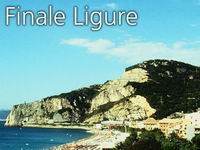 Finale Ligure: One and three-fold, a town of rocks and sea and with a gloroious history and the jewel of sea and mountain tourism in Liguria. Finale Ligure: One and three-fold, a town of rocks and sea and with a gloroious history and the jewel of sea and mountain tourism in Liguria.
Centuries ago, Finale separated the Sabazi Ligurians from the Ingauni Ligurians, located as it was on the boundary with the Roman Municipality of Vada Sabatia.
The town of Finale is really made up of three villages: Final Pia, the first one meets on arriving from varigotti, is a seaside borgo nestled around the Benedectine Abbey of Santa Maria Pia. The houses of Pia have kept their 16th century architectural features. Above Final Pia here are a number of fifth-to-seventh century villas qith cultivated grounds; in the past the area was home to avant-garde forms of agriculture, with hothouses, exotic species and citrus fruits; today superior vines are grown in the area. For as well as enjoying the sea and long walks, Finale is the ideal place to fill your glass with fine white wine and savour a delicious dinner in an intimate seafront restaurant.
Final Marina is also set right on the sea: a genoese outpost in 1365, it became Spanish in the 1600s; its promenade, shaded by lush green vegetation, is one of the most beautiful anywhere in Liguria.
Final Borgo, once known as Burgus Finarii, was founded in the late 1100s by the marquises of Del Carretto. It was capital of the Marquisate from the mid 1400s until the early 18th century; walls, palazzos and churches og Final Borgo date back to this time, making it one of the best-kept historic centres in the area around Savone. Exactly which of these historic buildings with their elegant black stone portals give the "Borgo" its noble aspect? Take for example the porta Reale, with the late gothic octagonal belltower of San Biagio which stands huddled against the town walls; or the convent of Santa Caterina (1359) with its late 15th century cloister, now home to the Museum of Finale and many prestigious cultural events. Then there are Piazza Garibaldi and Piazza del Tribunale with the 15th century building and the Porta Testa at the other end of the borgo. Somewhere in between the narrow streets are brought to life by craftsman's workshop selling wares made of Finale Stone, ceramic, glasses, wood and iron.
Higher up, beyond the Porta Mezzalama, stands the Castle of St. Giovanni, a mishmash of Medievale and Spanish architecture which looks stunning when lit up at night.
The Strada Berretta, open in 1666 to link Finale to the territories around Milan, once began here. A fifteen minute walk along the ancient track takes you to the ruins of Castel Govone, a military and residential building whose Lombard-style architecture reflects the ties between the Del carretto and the Sforza families.
Above Final Borgo, it's well woth making a journey up to Perti to take a look at its two churches: Sant'Eusebio, formerly Spanish in style but now very much of the Baroque, with its attractive waal-belfry and the late 15th century Nostra Signora di Loreto with its five belltowers, built in the Lombard Renaissance style on the lines of the Porticari chapel in Sant'Eustorgio in Milan.
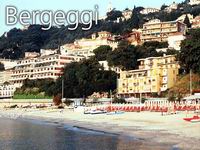 Bergeggi: a green, terraced hillside, the pinks and oranges of simple country houses: this is your first view of Bergeggi as you round the headland of Capo Vado fron the east. Standing way up on the hills, from the top of which you can see all the way down to the Cinque Terre on a clear winter's day, Bergeggi has not forgotten its agricultural roots despite its new vocation as a small but perfectly-formed summer holiday resort. Stretching out at the edge of the town are fine sandy and pebble beaches: on the promontory of Capo Maiolo stands the more recent tourist resort of Torre del Mare, hidden amid the lush green Mediterranean vegetation; its name brings to mind the ancient watchtower which was built, like many of its counter parts along the coast, to defend the area from invasion by barbarian people. Bergeggi: a green, terraced hillside, the pinks and oranges of simple country houses: this is your first view of Bergeggi as you round the headland of Capo Vado fron the east. Standing way up on the hills, from the top of which you can see all the way down to the Cinque Terre on a clear winter's day, Bergeggi has not forgotten its agricultural roots despite its new vocation as a small but perfectly-formed summer holiday resort. Stretching out at the edge of the town are fine sandy and pebble beaches: on the promontory of Capo Maiolo stands the more recent tourist resort of Torre del Mare, hidden amid the lush green Mediterranean vegetation; its name brings to mind the ancient watchtower which was built, like many of its counter parts along the coast, to defend the area from invasion by barbarian people.
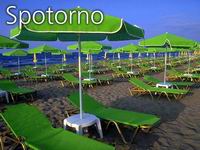 Spotorno: dont't be fooled by the 1960s apartment buildings which brim with the tourist in tyhe summer months: like all towns and villages of Liguria, Spotorno - now one of the leading resorts along the Riviera - has an ancient heart. The old borgo which runs parallel to the beach is plit in two by the caruggiu lungu its ancient thoroughfare, along which stand the delicately coloured parish church and brillantly tinged houses whose stone buttresses prop each other up; then there are the sea-promenade, with its row of exotic palms and the long, sandy beach. Spotorno: dont't be fooled by the 1960s apartment buildings which brim with the tourist in tyhe summer months: like all towns and villages of Liguria, Spotorno - now one of the leading resorts along the Riviera - has an ancient heart. The old borgo which runs parallel to the beach is plit in two by the caruggiu lungu its ancient thoroughfare, along which stand the delicately coloured parish church and brillantly tinged houses whose stone buttresses prop each other up; then there are the sea-promenade, with its row of exotic palms and the long, sandy beach.
Noli: according to the history books, Italy had four maritime republic, but, in fact there were more: Noli is one of the lesser-known examples. This beautiful village, overlooked by steep Mount Ursino which provided Dante with inpiration for the Purgatorio, enjoyed six centuries of maritime glory and political independence from 1202 to 1797. Its origins are lost in the mists of time, its name is Greek in origin (Neapolis, new city, then Nauli in the early Middle Ages) and it may have fought the Carthaginans alongside the romans; what we know for certain is that between the 6th and 7th centuries a baptistery and parish church stood on the side of the charming Medieval Church of San Paragorio.
In the town, surrounded by three city walls and dominated by the ruins of the 11th century castle, the influence of Genoese architecture is palpaple: of 72 towers-cum-dwellings which stood in the 12th century, only 8 remain today, including the 33 metres high Communal Tower which is still intact.
A walk through th ancient borgo start from the frescoed Porta Piazza overlooking the sea, taking in the nearby Palazzo del Comune and the tall 13th Communal Tower. Via Colombo, the town's main thoroughfare, is lined with beautiful 13th and 14ht century houses. Piazzetta Morando is exceptional for its strikingly tall Canto Tower, built on a trapezoidal plan and its views of the castle and walls which run down from the hill top. From here towards the hills, Via Colombo runs through Borgo San Giovanni which ends at the 14th century gate of that same name.
Varigotti and the Finale: The land between the promotiontories of Capo Noli and Caprazoppa, around the upland plain of the Manie, Val Ponci and the Communes fo Orco feligno and Calice Ligure, makes up an area of historical, geographical and environmental interest unrivalled in Liguria: the Finale.
The area, first settled in prehistoric times, is fashinating and truly unique for its geology: this karst upland plateau is filled with caves carved out by its streams and covered with Mediterranean vegetation, home to strange flowering plants and giant lizards. It's a wild landscape with high, rocky coastlines, ancient Roman bridges and rural and seaside villages rich in artistic tresaures; prehistoric Ligurians, Romans, Byzantines and Lombards, feudal lords and marquises, the Spanish and Genoese all passed through here.
At the western end of Baia dei Saraceni, stands the rocky green promontory of Punta Carena, with its watchover and the ruins of one of the castles built by the marquises of Del Carretto. To te west of Punta Carena lies the beautiful Borgo of Varigotti, a typical Mediterranean village whose terraces, gardens and lemon trees look straight out over the beach. The civitas marina of Varicottis was razed to the ground in 643 by Rotari, King of Lombards and the modern-day village was built in the 14th century. It had a thriving port which was filled in by its rival, Genoa.
Varigotti was a favourite spot for many 20th century painters from Italy and beyond because of its winter colours; the narrow alleyways of Varigotti were the inspiration for stories by Hemingway, Pavese and Gina Lagorio.
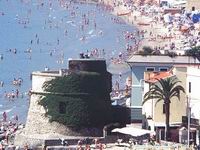 Alassio: Its origins are obscure. Alassio: Its origins are obscure.
According to some it was founded by the inhabitants of the surrounding heights, who came down to the coast in the tenth century to devote themselves to seafaring activities.
For others, the first nucleus was created by Benedictines from the island of Gallinara. They did in fact have a fief here up until the twelfth century, when the territory was sold to the Commune of Albenga, from which it did not gain its freedom until the sixteenth century. It was at this time that that the city walls, traces of which are still standing, and the imposing tower by the sea were built.
The most interesting of the religious buildings is the parish church of Sant'Ambrogio: although its tall campanile with a spire dates from the eleventh century, the church was rebuilt several times during the Renaissance and modern era.
The Palazzo Scofferi dates from the seventeenth-eighteenth century, as does the Palazzo Ferrero de Gubernatis, restored in the nineteenth century.
The energies that Alassio has devoted to the improvement and renovation of its tourist and bathing facilities has made it a seaside resort of international repute, where vacationers congregate not only on the beach but also at two other famous focal points: “Il Budello,” the narrow alley running parallel to the promenade and lined with stores, and the “muretto” of the public gardens, a wall with hundreds of ceramic tiles bearing the signatures of the many celebrities who have stayed in Alassio, commencing with Hemingway and Chaplin.
The tourist harbor, with two wharves and five piers, can accommodate around 400 boats.
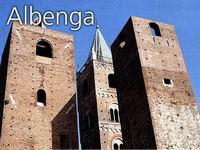 Albenga: Traces of the original Roman settlement can be seen in the remains of suburban villas along the route of the ancient Via Julia Augusta, and the ruins of the baths, an aqueduct, the amphitheater and a number of tombs, including the so-called “Pilone”. Albenga: Traces of the original Roman settlement can be seen in the remains of suburban villas along the route of the ancient Via Julia Augusta, and the ruins of the baths, an aqueduct, the amphitheater and a number of tombs, including the so-called “Pilone”.
The center of the city of Albenga has retained its compact medieval structure, with houses huddled against towers. The heart of the historic center is Piazza San Michele, on which the cathedral stands: structures from the eleventh century survive in the lower part of the façade and from the thirteenth century in the upper part. Its campanile, rebuilt in 1391-95 with five stories on a Romanesque base, is considered one of the finest late Gothic monuments in Liguria. The interior of the church, which has been restored to its medieval appearance, houses frescoes by Carrega, a panel painted by Pancalino in 1520 and a fifteenth-century Pentecost, in addition to the monumental nineteenth-century Serassi organ.
A few meters away stands the baptistery, which has remained practically intact since the fifth century, and the medieval complex of the Palazzo Vecchio del Comune (Old City Hall) with its charming tower on a base of black stone, dating from the fourteenth century. Behind the apse of the cathedral lies the Piazzetta dei Leoni, named after its three stone lions from the Renaissance, which is dominated by the sixteenth-century Palazzo Costa (now the bishop’s palace) and the battlemented tower of the same name.
Other relics of the Middle Ages can be seen in Piazza Girolamo Rossi, with its intact example of a fourteenth-century house, and on Via Bernardo Ricco which retains much of its original appearance.
A visit to the museums of Albenga also provides an opportunity explore the splendid buildings in which they are housed: the Palazzo Vecchio and the decorated rooms of Palazzo Peloso Cepolla, formerly the archbishop’s palace.
Nowadays the Albenga plain is used chiefly for the growing of potted plants, herbs and highvalue early produce, using advanced farming methods supported by the Center for Agricultural Experimentation and Assistance of the Savona Chamber of Commerce.
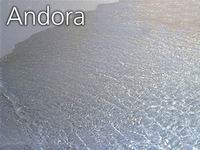 Andora: Facing onto the bay that extends between Capo Mele and Capo Cervo, it used to belong to the marchesi di Clavesana, who chose to make their home at Borgo Castello: the latter comprises the church of Santi Giacomo e Filippo in late Romanesque style, the tower that served as the entrance to the castle and, on the top of the hill, the little church of San Nicolò, the “Paraxu” or residence of the Genoese governor and the remains of the polygonal castle with its fortifications. Other relics from the medieval period include the large Romanesque bridge with its ten arches spanning the Merula River, a fountain and a number of small lookout towers to guard against raids by Barbary pirates on the surrounding hills. Andora: Facing onto the bay that extends between Capo Mele and Capo Cervo, it used to belong to the marchesi di Clavesana, who chose to make their home at Borgo Castello: the latter comprises the church of Santi Giacomo e Filippo in late Romanesque style, the tower that served as the entrance to the castle and, on the top of the hill, the little church of San Nicolò, the “Paraxu” or residence of the Genoese governor and the remains of the polygonal castle with its fortifications. Other relics from the medieval period include the large Romanesque bridge with its ten arches spanning the Merula River, a fountain and a number of small lookout towers to guard against raids by Barbary pirates on the surrounding hills.
An important seaside resort with a marina that can accommodate 670 boats, Andora has embraced the tourist industry and expanded all its structures, with particular emphasis on sports facilities: the town offers courses in swimming, sailing and windsurfing, along with tennis courts and riding schools. One of the most interesting events of the year is the summer program of concerts known as the Estate Musicale Andorese.
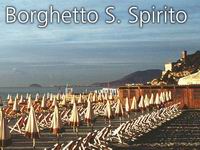 Borghetto Santo Spirito: Founded in 1288 by the Commune of Albenga, which ringed it with walls to make it a defensive outpost on the eastern seashore, Borghetto took its name from the monastic hospice of Santo Spirito, established in the twelfth century. It was a fief of the Doria family and then came under the rule of the republic of Genoa in the first half of the fourteenth century. Borghetto Santo Spirito: Founded in 1288 by the Commune of Albenga, which ringed it with walls to make it a defensive outpost on the eastern seashore, Borghetto took its name from the monastic hospice of Santo Spirito, established in the twelfth century. It was a fief of the Doria family and then came under the rule of the republic of Genoa in the first half of the fourteenth century.
A few remains of the thirteenth-century walls have been incorporated into some of the town’s houses. The parish church of San Matteo, built at the beginning of the seventeenth century, has a campanile in the baroque style. It houses a wooden statue of St. Matthew by Maragliano, a statue of St. Mary of the Olivari, a painting of the Martyrdom of St. Matthew by G. Badracco which includes a seventeenth-century view of Borghetto Santo Spirito and another depicting the Martyrdom of St. Apollonia by D. Fiasella. The Borelli Castle at Capo Santo Spirito was built in the nineteenth century over a seventeenth-century monastery of the Minim Fathers and is surrounded by a splendid pine wood.
 Pietra Ligure: Situated on the Riviera to the west of Capo Caprazoppa, it was a Byzantine stronghold with the name of Castrum Petrae, perched like an eagle’s aerie in a picturesque setting on a wild and isolated limestone crag (“la Pietra”) to the east of the present town. Pietra Ligure: Situated on the Riviera to the west of Capo Caprazoppa, it was a Byzantine stronghold with the name of Castrum Petrae, perched like an eagle’s aerie in a picturesque setting on a wild and isolated limestone crag (“la Pietra”) to the east of the present town.
In the twelfth century the castrum passed to the bishop of Albenga, who had it rebuilt, and in 1385 it was sold to Genoa by Pope Urban VII. Recently the fortress has been consolidated and its rooms used to house exhibitions of porcelain, prints and antique furniture. It also contains an extensive library with a bar and restaurant. The oldest of the monuments documenting Pietra Ligure’s history is the oratory of the Bianchi, dating from the tenth century and now used as an auditorium, located on the characteristic Piazza Vecchia or Piazza del Mercato.
It used to be the parish church, dedicated to the town’s patron saint Nicholas, and was restructured in the baroque era. The interior is divided into a nave and two aisles with columns made of local stone. It now houses oil measures from the republic of Genoa and the remains of a medieval well that used to be located in the square in front. The campanile still has the sacred bell that, according to tradition, was rung by the hand of St. Nicholas to announce the end of the outbreak of plague in 1525. The present parish church of San Nicolò dates from the second half of the eighteenth century: the interior, roofed by a fine, frescoed vault, is a huge rectangular space surrounded by chapels of different sizes. It contains a collection of pictures and a wooden choir from the sixteenth century, which used to be in Marseilles Cathedral.
In addition to being a popular summer vacation resort, Pietra Ligure is famous for its shipyard and hospital facilities, which include the complex of Santa Corona, a renowned rehabilitation center.
Food and wine
Although inspired by traditional “Genoese” cuisine, whose fundamental ingredients are olive oil and herbs (parsley, basil, thyme, marjoram, oregano, rosemary, etc.), the seafood and vegetable dishes of the Riviera delle Palme, from Varazze to Andora, present the tourist and gourmet who wishes to explore the character of the local cooking with original variations on the theme.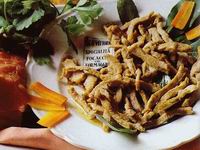
A cuisine that is in the first place much “greener,” commencing with the filling for ravioli – once considered “the queen of first courses” – in which vegetables (beet, borage, chicory and endives) predominate over meat and eggs.
Even the classic “Genoese stuffed breast of veal” contains much more egg, along with brain, marrow and sweetbreads that do not appear in the Riviera version. In both dishes, however, we find, alongside cheese, the indispensable flavor of the sweet marjoram also known as persa or persiga (at Albenga and Alassio): of undoubted Levantine, or Persian, origin, it is a testimony to maritime trade links with faraway places.
The inland region, which borders to the north on the province of Alessandria and, though only to a minimal extent, that of Asti, while opening to the west on the “Provincia Granda” of Cuneo, feels the beneficial influence of this area of “haute cuisine” and is able to offer an extraordinary series of typical specialties: highly original and tasty, they range from “white polenta” to “bacialli” and the “tire” of Altare. Each valley, each town, has interesting culinary ideas to offer to the curious visitor.
A real opportunity for the rediscovery of ancient flavors that have not yet been lost. Without of course forgetting the “traditional” dishes, modern chefs are always coming up with new and much-appreciated combinations of seafood and garden produce, such as the wonderful fantasies of “pesce spade in carpaccio” (raw swordfish) or “polpo tiepido in salsa Rossese” (warm octopus in Rossese sauce), “linguine con scampi e zucchine” and the “spunciacurrente” (a kind of small octopus) fried, stewed or simply boiled and served with a dash of taggiasca extra virgin olive oil.
TRUFFLES
The most unexpected surprise in the province of Savona, and found nowhere else in Liguria, is the seductive truffle. A few kilometers beyond the Colle di Cadibona, in that extreme southern spur of the Langhe Cuneensi comprised between the communes of Cairo Montenotte, Millesimo, Carcare and Dego – and especially in the wood of Santa Giulia – it is possible to find not only the “black truffle”, a more or less close relative of the one from Norcia and even that of Périgord, the honor and pride of French cooking, but also the even more stronglyscented white one, sometimes called the tartuffo d’Alba, to be cut, judiciously, into a shower of thin slices, of tiny petals.... A further gastronomic delight in addition to that of mushrooms, the true collective “mania” of the autumn for both residents and guests, gathered in the splendid chestnut and beech woods.
EXTRA VIRGIN OLIVE OIL
Extra virgin olive oil di primo ruggio, i.e. cold pressed, made by traditional methods, is the undisputed sovereign of Ligurian cuisine. The oil made from the taggiasca olive, grown in the valleys of Andora and the Albenga region as well as in the area around Imperia, has a delicate, slightly fruity flavor, sometimes with an aftertaste of almonds. 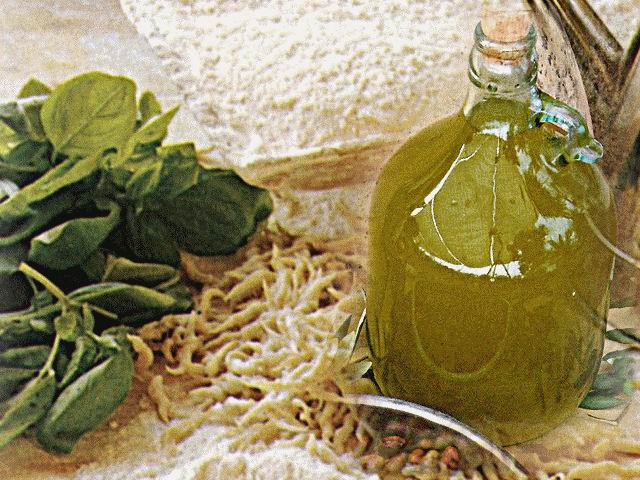
Other oils from the province of Savona that are prized for their flavor are the ones produced from olives of the Colombaia or Colombara, Frantoio and Pinola varieties. The latter, with its delicate taste of pine kernels, is typical of Arnasco, in the hinterland of Albenga, where it is grown on terraces fully exposed to the south. Going for the newly-pressed oil, from November to March, is an occasion not to be missed by the tourist-gourmet: a fascinating journey to be made through the splendid valleys where the olives are grown, just back from the coast, at the time when they are being picked by hand or beaten down from the trees, or visiting the oil mills, or gombi as they are known locally, to watch the olives being crushed and pressed. Recently the olive oil produced in Liguria has been recognized by the assignment of a mark of quality, D.O.P. (Denominazione d’origine protetta or “protected name of origin”). This provides the consumer with an additional guarantee that the oil has been made from olives picked between November and January and brought to the oil press within forty-eight hours.
BASIL
Ligurian basil (baxiaicò in the local dialect), grown on the coast in the bracing sea air, is the fundamental ingredient in the classic pesto sauce. Thanks to cultivation in greenhouses, it is now available all the year round. Indeed the best time to taste it – according to the wellinformed gourmet – is in the winter, made with basil from a hothouse or grown on a balcony, in the slanting rays of sunlight of one of the Ligurian alleys known as carruggi, with its small, pale green leaves and intoxicating, unique scent.
At the end of spring, on the other hand, basil starts to emerge from the vegetable garden: stronger in flavor, with a slight hint of mint, it is particularly suitable for sauces made with fresh tomato. Pesto is a strictly raw sauce: thus it is a great mistake to let it heat up during preparation in a blender. Be careful, therefore, to use the slowest speed after steeping the leaves in abundant local extra virgin oil and to pause occasionally during the process to avoid overheating of the blades. In addition, it is recommended that pasta seasoned with pesto not be sautéed in a frying pan.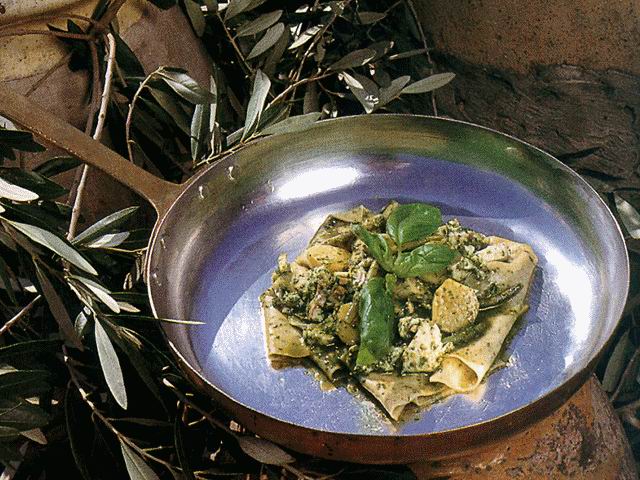
ARTICHOCKES
One of the most delicious specialties of the Riviera Ligure delle Palme is undoubtedly the spiny artichoke of Albenga. With the hard external petals removed – be careful not to prick yourself – this particular variety of artichoke is the only one that can be eaten in pinzimonio, i.e. raw with a dip made of extra virgin olive oil, vinegar, salt and, if desired, pepper. The artichokes of this region are also much appreciated “breaded” and fried, in the classic Easter dish of artichoke pie, or stewed with lamb or even better kid.
ASPARAGUS
The purple asparagus of Albenga may rightly be considered one of the most refined specialties not just of Ligurian cooking but of Grande Cuisine in general. Highly appreciated in numerous dishes (especially when it is considered “fine early produce”), it is given pride of place on the menus of the best restaurants, even outside the region.
WINES
An extraordinary range of typical wines provide a worthy accompaniment to all the culinary specialties of the stretch of coast between Varazze and Andora, from fish dishes to those based on vegetables and meat, especially white meats like rabbit, lamb and kid. There is a marked preponderance of white wines, in addition to the rosé called Rossese d’Albenga and Ormeasco. Here we give a list of them with their principal characteristics:
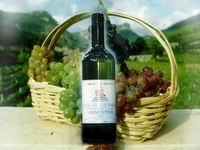 VERMENTINO (D.O.C.) – a clear, straw yellow in color, sometimes with golden reflections, it has a full, discreetly intense and persistent but delicate bouquet, with a scent of wild herbs and hints of honey, pear, peach and woodland resins, and a dry but mellow, pungent and delicately warm taste, with a full body and a pleasantly bitter bottom. An ideal accompaniment to seafood appetizers, savory first courses with delicate white sauces made with herbs and above all pesto! It is ideally suited to a menu that includes a second course of fine salt-water fish, boiled and served with extra virgin olive oil. VERMENTINO (D.O.C.) – a clear, straw yellow in color, sometimes with golden reflections, it has a full, discreetly intense and persistent but delicate bouquet, with a scent of wild herbs and hints of honey, pear, peach and woodland resins, and a dry but mellow, pungent and delicately warm taste, with a full body and a pleasantly bitter bottom. An ideal accompaniment to seafood appetizers, savory first courses with delicate white sauces made with herbs and above all pesto! It is ideally suited to a menu that includes a second course of fine salt-water fish, boiled and served with extra virgin olive oil.
PIGATO (D.O.C.) – Very similar to Vermentino, but with nuances that cannot or at least should not escape the expert. It too is a clear, straw yellow color, with slight golden reflections, and has a full, intense, persistent but delicate and fruity aroma, with hints of ripe peach, flowers and herbs, in particular sage and broom, and a dry but pleasantly mellow and warm taste, with a good and wellcomposed, steady structure and a slightly bitter bottom. An ideal accompaniment for mushroom hors-d’oeuvres, first courses with walnut and pesto sauces, classic vegetable dishes (pasqualina or Easter pie and artichoke pie), fish-based second courses with delicate white sauces and salt-water fish baked in paper.
ROSSESE D’ALBENGA OR DI CAMPOCHIESA (D.O.C.) – Absolutely not to be confused with that of Dolceacqua, it is a more or less deep ruby red and has a full, persistent fruity and slightly vinous bouquet with hints of wild strawberry and raspberry. The taste is dry but fairly mellow, pungent and delicately warm, with a medium body and a typical touch of bitterness. It goes well with first courses seasoned with red sauces. Thus it is a good accompaniment not only for meat dishes but also for tomato sauces, where it provides a more appropriate combination than with white wines.
LUMASSINA – Made from a vine that grows along the coast as far as Savona, taking the name “Mataosso” at Spotorno and Noli and “Buzzetto” around Savona and Quiliano. It too is a clear, straw yellow color, with greenish reflections, but its delicate and persistent aroma contains scents of damp wild herbs and hints of slightly wilted wildflowers. A dry, light and very fresh taste that is pleasing to the palate. It goes well with griddlecakes of fish and vegetables, fish sauces or pasta, even when fairly rich, and sardines and mackerel, either fried or cooked with vegetables. However, we cannot leave the province of Savona without mentioning, even if only in passing, “VERDEA,” a white wine originating in Tuscany that is ideally suited to first courses of white meat seasoned with spices or herbs, baked fish with mushrooms, etc. The great and legendary Granaccia, on the other hand, made with grapes from the Alicante vine in some parts of the commune of Quiliano, is a deep red in color, with a touch of violet when it is young and becoming a deep ruby with garnet reflections after aging from three to four years. It is an excellent accompaniment to red meat, game and seasoned but mild cheeses.
PHOTOS AND TEXTS: ARCHIVIO APT - RIVIERA DELLE PALME |



 In the garden
In the garden Modigliani and the Montparnasse Adventure
Modigliani and the Montparnasse Adventure Madonna di Campiglio - Pinzolo - Val Rendena Travel Guide
Madonna di Campiglio - Pinzolo - Val Rendena Travel Guide



 There are many buildings and ruined towers worth visiting in the nearby area. Via Pia leads on to the porticoes of Via Paleocapa, but it is worthwhile making a detour along Via Aonzo towards Piazzetta del Vescovado and the 18th century Palazzo Vescovile, not to mention the Cathedral square which stands at the rear of Palazzo Della Rovere.
There are many buildings and ruined towers worth visiting in the nearby area. Via Pia leads on to the porticoes of Via Paleocapa, but it is worthwhile making a detour along Via Aonzo towards Piazzetta del Vescovado and the 18th century Palazzo Vescovile, not to mention the Cathedral square which stands at the rear of Palazzo Della Rovere..jpg) Varazze: a marina packed with pristine white sailing boats, set against a backdrop of rocky peaks and cluster pines: approaching Varazze from the coast road (the "Aurelia"), it is easy to see why the Romans called it ad Navalia. The name Varagine, coined as early as 967, had the same meaning: woodland thick with excellent timber for boat building, and beaches ideal for launching craft; the links between Varazze and the sea are among the oldest and most stable to be found anywhere in Liguria. Not forgetting its shipyards, first and foremost Baglietto, which have brought honour to this charming town throughout the 20th century and beyond. Of course, people eventually realised that the sea could be used for bathing, revitalising and warming their minds and bodies after a year of wintry skies, or simply strolling along the palm-lined flowering promenade. The era of vacationing had begun.
Varazze: a marina packed with pristine white sailing boats, set against a backdrop of rocky peaks and cluster pines: approaching Varazze from the coast road (the "Aurelia"), it is easy to see why the Romans called it ad Navalia. The name Varagine, coined as early as 967, had the same meaning: woodland thick with excellent timber for boat building, and beaches ideal for launching craft; the links between Varazze and the sea are among the oldest and most stable to be found anywhere in Liguria. Not forgetting its shipyards, first and foremost Baglietto, which have brought honour to this charming town throughout the 20th century and beyond. Of course, people eventually realised that the sea could be used for bathing, revitalising and warming their minds and bodies after a year of wintry skies, or simply strolling along the palm-lined flowering promenade. The era of vacationing had begun..jpg) Celle Ligure: Celle shares its name with a pretty town in the north of Germany. There, trellised houses and baronial castles speak to us of the lives and history of its inhabitants; here, the colourful facades of the tall buildings which look out over narrow caruggi or alleyways go to make in one of Liguria's most charming and best-kept seaside villages. Double rows if centuries-old houses, painted in bright, brilliant colours - enabling the fishermen of old to distinguish their homes from the sea - a long, winding passageway, closed to traffic and animated by a thousand-and-one tiny shops, by the hubbub of passers-by, and then a long sandy beach lined with multicoloured bathing huts and sunshades joins the village to the great blue plateau out yonder, stretching off to the east towards the leafy new area of Piani di Celle and, beyond, to Varazze.
Celle Ligure: Celle shares its name with a pretty town in the north of Germany. There, trellised houses and baronial castles speak to us of the lives and history of its inhabitants; here, the colourful facades of the tall buildings which look out over narrow caruggi or alleyways go to make in one of Liguria's most charming and best-kept seaside villages. Double rows if centuries-old houses, painted in bright, brilliant colours - enabling the fishermen of old to distinguish their homes from the sea - a long, winding passageway, closed to traffic and animated by a thousand-and-one tiny shops, by the hubbub of passers-by, and then a long sandy beach lined with multicoloured bathing huts and sunshades joins the village to the great blue plateau out yonder, stretching off to the east towards the leafy new area of Piani di Celle and, beyond, to Varazze. Finale Ligure: One and three-fold, a town of rocks and sea and with a gloroious history and the jewel of sea and mountain tourism in Liguria.
Finale Ligure: One and three-fold, a town of rocks and sea and with a gloroious history and the jewel of sea and mountain tourism in Liguria. Bergeggi: a green, terraced hillside, the pinks and oranges of simple country houses: this is your first view of Bergeggi as you round the headland of Capo Vado fron the east. Standing way up on the hills, from the top of which you can see all the way down to the Cinque Terre on a clear winter's day, Bergeggi has not forgotten its agricultural roots despite its new vocation as a small but perfectly-formed summer holiday resort. Stretching out at the edge of the town are fine sandy and pebble beaches: on the promontory of Capo Maiolo stands the more recent tourist resort of Torre del Mare, hidden amid the lush green Mediterranean vegetation; its name brings to mind the ancient watchtower which was built, like many of its counter parts along the coast, to defend the area from invasion by barbarian people.
Bergeggi: a green, terraced hillside, the pinks and oranges of simple country houses: this is your first view of Bergeggi as you round the headland of Capo Vado fron the east. Standing way up on the hills, from the top of which you can see all the way down to the Cinque Terre on a clear winter's day, Bergeggi has not forgotten its agricultural roots despite its new vocation as a small but perfectly-formed summer holiday resort. Stretching out at the edge of the town are fine sandy and pebble beaches: on the promontory of Capo Maiolo stands the more recent tourist resort of Torre del Mare, hidden amid the lush green Mediterranean vegetation; its name brings to mind the ancient watchtower which was built, like many of its counter parts along the coast, to defend the area from invasion by barbarian people. Spotorno: dont't be fooled by the 1960s apartment buildings which brim with the tourist in tyhe summer months: like all towns and villages of Liguria, Spotorno - now one of the leading resorts along the Riviera - has an ancient heart. The old borgo which runs parallel to the beach is plit in two by the caruggiu lungu its ancient thoroughfare, along which stand the delicately coloured parish church and brillantly tinged houses whose stone buttresses prop each other up; then there are the sea-promenade, with its row of exotic palms and the long, sandy beach.
Spotorno: dont't be fooled by the 1960s apartment buildings which brim with the tourist in tyhe summer months: like all towns and villages of Liguria, Spotorno - now one of the leading resorts along the Riviera - has an ancient heart. The old borgo which runs parallel to the beach is plit in two by the caruggiu lungu its ancient thoroughfare, along which stand the delicately coloured parish church and brillantly tinged houses whose stone buttresses prop each other up; then there are the sea-promenade, with its row of exotic palms and the long, sandy beach. Alassio: Its origins are obscure.
Alassio: Its origins are obscure.  Albenga: Traces of the original Roman settlement can be seen in the remains of suburban villas along the route of the ancient Via Julia Augusta, and the ruins of the baths, an aqueduct, the amphitheater and a number of tombs, including the so-called “Pilone”.
Albenga: Traces of the original Roman settlement can be seen in the remains of suburban villas along the route of the ancient Via Julia Augusta, and the ruins of the baths, an aqueduct, the amphitheater and a number of tombs, including the so-called “Pilone”. Andora: Facing onto the bay that extends between Capo Mele and Capo Cervo, it used to belong to the marchesi di Clavesana, who chose to make their home at Borgo Castello: the latter comprises the church of Santi Giacomo e Filippo in late Romanesque style, the tower that served as the entrance to the castle and, on the top of the hill, the little church of San Nicolò, the “Paraxu” or residence of the Genoese governor and the remains of the polygonal castle with its fortifications. Other relics from the medieval period include the large Romanesque bridge with its ten arches spanning the Merula River, a fountain and a number of small lookout towers to guard against raids by Barbary pirates on the surrounding hills.
Andora: Facing onto the bay that extends between Capo Mele and Capo Cervo, it used to belong to the marchesi di Clavesana, who chose to make their home at Borgo Castello: the latter comprises the church of Santi Giacomo e Filippo in late Romanesque style, the tower that served as the entrance to the castle and, on the top of the hill, the little church of San Nicolò, the “Paraxu” or residence of the Genoese governor and the remains of the polygonal castle with its fortifications. Other relics from the medieval period include the large Romanesque bridge with its ten arches spanning the Merula River, a fountain and a number of small lookout towers to guard against raids by Barbary pirates on the surrounding hills. Borghetto Santo Spirito: Founded in 1288 by the Commune of Albenga, which ringed it with walls to make it a defensive outpost on the eastern seashore, Borghetto took its name from the monastic hospice of Santo Spirito, established in the twelfth century. It was a fief of the Doria family and then came under the rule of the republic of Genoa in the first half of the fourteenth century.
Borghetto Santo Spirito: Founded in 1288 by the Commune of Albenga, which ringed it with walls to make it a defensive outpost on the eastern seashore, Borghetto took its name from the monastic hospice of Santo Spirito, established in the twelfth century. It was a fief of the Doria family and then came under the rule of the republic of Genoa in the first half of the fourteenth century. Pietra Ligure: Situated on the Riviera to the west of Capo Caprazoppa, it was a Byzantine stronghold with the name of Castrum Petrae, perched like an eagle’s aerie in a picturesque setting on a wild and isolated limestone crag (“la Pietra”) to the east of the present town.
Pietra Ligure: Situated on the Riviera to the west of Capo Caprazoppa, it was a Byzantine stronghold with the name of Castrum Petrae, perched like an eagle’s aerie in a picturesque setting on a wild and isolated limestone crag (“la Pietra”) to the east of the present town. 


 VERMENTINO (D.O.C.) – a clear, straw yellow in color, sometimes with golden reflections, it has a full, discreetly intense and persistent but delicate bouquet, with a scent of wild herbs and hints of honey, pear, peach and woodland resins, and a dry but mellow, pungent and delicately warm taste, with a full body and a pleasantly bitter bottom. An ideal accompaniment to seafood appetizers, savory first courses with delicate white sauces made with herbs and above all pesto! It is ideally suited to a menu that includes a second course of fine salt-water fish, boiled and served with extra virgin olive oil.
VERMENTINO (D.O.C.) – a clear, straw yellow in color, sometimes with golden reflections, it has a full, discreetly intense and persistent but delicate bouquet, with a scent of wild herbs and hints of honey, pear, peach and woodland resins, and a dry but mellow, pungent and delicately warm taste, with a full body and a pleasantly bitter bottom. An ideal accompaniment to seafood appetizers, savory first courses with delicate white sauces made with herbs and above all pesto! It is ideally suited to a menu that includes a second course of fine salt-water fish, boiled and served with extra virgin olive oil.